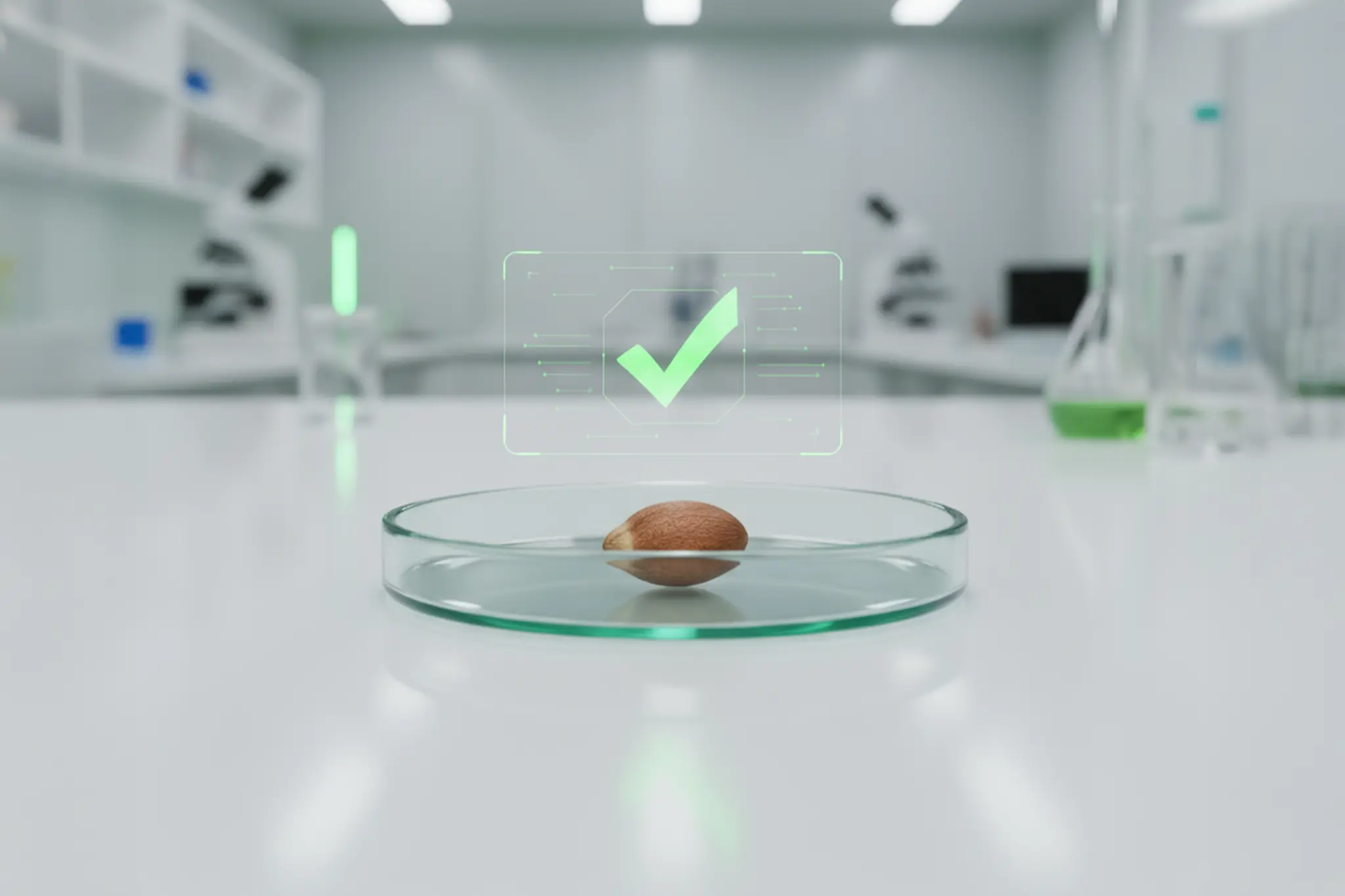Seed certification is vital to building trust and confidence in the customer and is the key to sustainable farming. Certification can also be considered as the first step toward a successful crop cycle. Research indicates that to the total production, the direct contribution of a quality seed varies between 15–20% (depending on the crop). Efficient management of specific other inputs increases the scope of seed contribution to ,a href=”https://www.aosca.org/programs-and-services/seed-certification/”> as high as 45%.
Seed certification- plant with confidence
Seed certification is a process by which the quality of seed is evaluated and certified by a government-authorized organization. The purpose of seed certification is to ensure that the seed is sold to farmers and gardeners and meets specific standards for genetic purity, seed health, and varietal identity. The process of seed certification typically involves a series of inspections and tests to determine the quality of the seed, and the seed must meet specific criteria in order to be certified.
Once the seed has been certified, it is given a certificate and is eligible for sale as certified seed. Seed certification provides a number of benefits for farmers, gardeners, and the environment. By using accredited seeds, farmers and gardeners can be confident that they are planting seeds that will produce crops with the desired characteristics, and that will not be contaminated with unwanted plant material. Additionally, the use of certified seed helps to conserve genetic diversity and ensures that the seed used for cultivation is of high quality and free from disease.
On the stakeholder side, accurately identifying crop varieties ensures that every stakeholder handling the seed–from the breeder to the distributor–offers high-quality, low-contaminant seeds at every stage of the development process. This makes seed certification a crucial aspect for farmers and seed companies alike.
Certified seeds will demonstrate enhanced traits such as pest resistance, improved grazing tolerance, and herbicide resilience. Regarding identity markers for seed quality, there are four classes of certified seeds: nucleus, breeder, foundation, and certified.
The 7-step process of seed certification
The seed certification process is designed to ensure that farmers and gardeners have access to high-quality seeds that will produce crops with the desired characteristics and will be free from unwanted plant material and diseases. The use of certified seed is important for conserving genetic diversity and ensuring the sustainable use of seed resources.
The seed certification process typically involves several stages, including
1. Application for seed certification
The seed producer submits an application to the seed certification agency for certification of their seed.
2. Inspection by the seed certification agency
The seed certification agency inspects the seed production fields to ensure that they meet the required standards for seed production and that the seed meets the criteria for varietal purity, seed health, and other factors.
3. Sampling of seeds
A representative sample of the seed is taken and tested in a laboratory to determine its genetic purity, seed health, and other characteristics.
4. Testing of seeds
The seed is subjected to various tests to determine its quality, including tests for germination, physical purity, and genetic purity.
5. Certification
If the seed meets all the requirements, it is certified and a certificate is issued.
6. Monitoring post-certification
The seed certification agency monitors the seed after certification to ensure that it continues to meet the standards for seed quality.
7. Renewal of seed certification
The seed certification must be renewed each year, and the seed certification agency will conduct annual inspections and testing to ensure that the seed continues to meet the required standards.
4 primary challenges of a seed certification process
Seed certification is vital to ensure seeds meet strict standards and are disease-free. Various parameters must be carefully assessed to decide which seeds comply with quality benchmarks. As with any regulatory procedure, this also comes with its challenges. For the scope of this article, we will focus on four primary challenges.
1. The undaunting task of covering farming standards set by certification services
Setting the right standards and benchmarks for seed production is not easy. Certification companies set farming standards based on the requirements and safety of end consumers in a customized Farm-Level Survey Form. It becomes challenging to outline the basic requirements to safeguard the end consumer’s and farmer’s interests.
AI-powered technological farming apps can tackle this challenge by offering the following:
A. Acceptable standards of seed viability
Outline acceptable standards of seed viability, vigor, purity, and health and disseminate this information among key stakeholders–from the government and the farmer to the certification agency and the seed companies.
B. Awareness of seed health
Drive awareness among farmers about seed health and gather critical data by way of a customized farm-level survey form–one that’s available at the tip of their fingertips.
C. Evolving best practices
Help certification agencies identify newer varieties with evolved best practices and delegate appropriate names as needed.
An improved and digitized data collection process can lay the foundation for an accurate and up-to-date seed certification process–a win-win for all.
An improved and digitized data collection process can lay the foundation for an accurate and up-to-date seed certification process–a win-win for all.
2. Maintaining a record of each farm activity after completion
Often, farmers face tremendous difficulty while recording the status and success of each seed activity after completion. Without a systematic approach to seed development documentation, the output and health can suffer. By extension, the certification standards can plummet.
Adoption of digital farming can-
- A. Ensure continuous, accurate, and real-time documentation of the seed origin as well as traceability
- B. Track and even geotag the status of each production process
- C. Drive a more proactive approach towards identifying and reporting issues (for instance, fake labels within the supply chain) among key stakeholders promptly.
3. Need to regulate and track critical parameters
Another critical challenge encountered by seeding companies is regulating and tracking critical parameters that impact seed quality, such as:
- A. The amount of quality seed used
- B. Pesticide residue
- C. Seed health alerts raised
- D. Issues that need resolution during cultivation
- E. Crop quality
Effective use of Agtech tools like drones in agriculture, artificial intelligence and machine learning (AI/ML), remote sensing, and satellite imagery goes a long way in regulating the above parameters. Consolidating inputs AI/ML tools provide actionable insights to farmers on crop health, weather, pests, and disease. Using digitization in agriculture, farmers’ actions can also be tracked.
4. Eliminating the ever-present problem of seed adulteration
Seed adulteration poses a massive challenge to seeding companies, as it is extremely difficult to differentiate between a spurious seed and a genuine one. This arises from the lack of traceability in supply chain practices, which impairs the verification of seed authenticity. Traceability can be achieved by leveraging QR-code tagging during the process of packaging and warehousing. An end-to-end solution for packhouse and processing will ensure traceability, compliance, quality control, and flexible inventory management.
Seed certification- take control of your harvest with technology
In light of the challenges mentioned above, extracting insight-driven reports and submitting them for quality certification becomes difficult. Integrating technology can ease these issues faced by seed companies and facilitate end-to-end traceability of produce, even beyond the point of harvest. It can also help monitor the amount of agrochemicals and pesticides used.
One such use case is intelligent Agtech company Cropin’s partnership with PAGREXCO (Punjab Agri Export Corporation), which improved the quality and traceability of potato seeds. The use of Agtech solutions provided by Cropin helped improve seed quality and the production process. Cropin’s ‘Smartfarm’, a farm management software helped PAGREXCO with real-time intelligence and end-to-end traceability, in addition to enabling two-way communication between farmers and PAGREXCO.
Thus digitalizing the seed certification process can bring greater traceability across farm-to-fork and transparency into the ecosystem and enhance consumers’ trust. It also has the potential to improve farmers’ income. It can improve the efficiency, integrity, and security of certification systems and positively impact seed production at the ground level.
Ready to unlock the future of agriculture?
Explore Cropin Sage and witness the power of real-time agri-intelligence.








